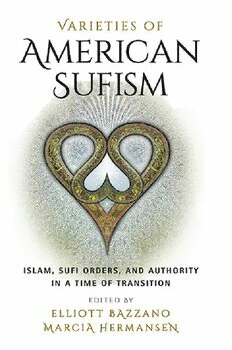
Varieties of American Sufism: Islam, Sufi Orders, and Authority in a Time of Transition PDF
Preview Varieties of American Sufism: Islam, Sufi Orders, and Authority in a Time of Transition
Varieties of American Sufism Varieties of American Sufism Islam, Sufi Orders, and Authority in a Time of Transition Edited by ELLIOTT BAZZANO and MARCIA HERMANSEN Cover art by Michael Green (michaelgreenarts.com) Published by State University of New York Press, Albany © 2020 State University of New York All rights reserved Printed in the United States of America No part of this book may be used or reproduced in any manner whatsoever without written permission. No part of this book may be stored in a retrieval system or transmitted in any form or by any means including electronic, electrostatic, magnetic tape, mechanical, photocopying, recording, or otherwise without the prior permission in writing of the publisher. For information, contact State University of New York Press, Albany, NY www.sunypress.edu Library of Congress Cataloging-in-Publication Data Names: Bazzano, Elliott, 1983– editor. | Hermansen, Marcia K., 1951– editor. Title: Varieties of American Sufism : Islam, Sufi orders, and authority in a time of transition / Elliott Bazzano and Marcia Hermansen, editors. Description: Albany : State University of New York Press, [2020] | Includes bibliographical references and index. Identifiers: LCCN 2019017374 | ISBN 9781438477916 (hardcover : alk. paper) | ISBN 9781438477923 (ebook) Subjects: LCSH: Sufism—United States. | Islam—United States. | Islamic sects— United States. Classification: LCC BP188.8.U6 V37 2020 | DDC 297.40973—dc23 LC record available at https://lccn.loc.gov/2019017374 10 9 8 7 6 5 4 3 2 1 Contents Acknowledgments vii Introduction ix Marcia Hermansen 1 The Message in Our Time: Changing Faces and Identities of the Inayati Order in America 1 Geneviève Mercier-Dalphond 2 The Golden Sufi Center: A Non-Islamic Branch of the Naqshbandiyya-Mujaddidiyya 27 William Rory Dickson 3 The Bawa Muhaiyaddeen Fellowship: Diverse Identities and Negotiated Spaces 55 Merin Shobhana Xavier 4 A Shadhiliyya Sufi Order in America: Traditional Islam Meets American Hippies 85 Elliott Bazzano 5 The Mevlevi Order of America 121 Simon Sorgenfrei 6 From the Balkans to America: The Alami Tariqa in Upstate New York 151 Julianne Hazen vi Contents 7 “There is an ‘I’ deeper than me”: The Ansari Qadiri Rifa‘i Tariqa and Transcendence in America 175 Melinda Krokus 8 When the Divine Flood Reached New York: The Tijani Sufi Order among Black American Muslims in New York City 209 Rasul Miller Contributors 237 Index 241 Acknowledgments Merin Shobhana Xavier’s chapter 3 is based on Sacred Spaces and Trans- national Networks: Bawa Muhaiyaddeen and Contemporary Shrine Cultures (2018). Thank you to Bloomsbury Press for permission to republish some of this material. Julianne Hazen’s chapter 6 draws on material from her monograph Sufism in America: The Alami Tariqa of Waterport, New York. London: Lexington Books, 2017. vii Cover Art by Michael Green The cover artist, Michael Green, is known for his work on The Illumi- nated Rumi and The Illustrated Prayer. Samples of his art may be viewed and ordered at https://www.michaelgreenarts.com. His explanation of the cover image, chosen to represent American Sufism, follows: The art on the cover of this book illuminates a teaching given by His holiness Bawa Muhaiyaddeen, one of the Sufi masters visited in the following pages. Within every human breast shine two hearts, one hid within the other. The outer heart points downward, and loves chosen things of form in the world—our family and friends, our lands and possessions. The inner heart is a secret heart, and it gazes upward with facxe-to-face seeing into the sacred presence of the Great Mystery. The light of singularity abounds in fuill gladness, like coming upon light in thick darkness, like receiving treasure in poverty, and existence is delivered from all limitations. May we open, may we flower, may we know our deep desire, May we walk this world with eyes wide open, Walk this world with hearts on fire. BLESSED BE viii Introduction Marcia Hermansen This volume brings together detailed ethnographic and historical work on diverse Sufi orders operating in the United States. While it is generally observed that the Indian mystic Inayat Khan introduced Sufism to the United States in 1910,1 it was not until the late 1960s and early 1970s that we find larger numbers of Americans participating in movements related to Sufism, together with growing public awareness of the phenomenon. The themes of “what is a Sufi?” and “what is the relationship of Sufism to ‘orthodox’ or ‘mainstream’ Islam?” are ones that vex this study and are often debated among American Sufis themselves, taking on new dimensions with an upsurge in Islamic revival on a global scale beginning in the 1970s. As American popular culture and the popular imagination is always changing and evolving, both in its self-understanding and in its view of Islam, Muslims, and Muslim-majority countries, the realities and the images of Sufism encountered by Americans have likewise not remained static. Participants in the movements studied here are therefore situated in and view themselves against a diverse and contested background of both the Islamic and the Sufi. The appeal and significance of the chapters gathered here is that many of them provide for the first time detailed reports on certain Sufi orders by scholars who have carried out in-depth participant observation of the movements involved. Such studies are able to provide us with rel- evant examples of the current and ongoing challenges facing small and somewhat exotic religious groups in diverse American contexts. Rather than focusing exclusively on leaders, histories, and texts, many chapters ix
